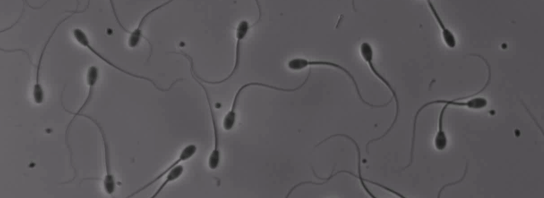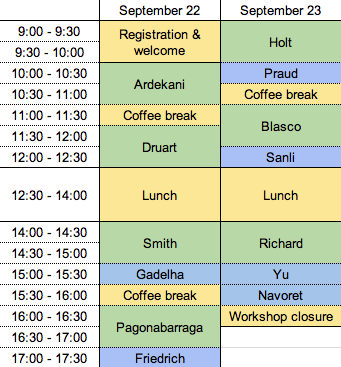Workshop “Collective dynamics of active particles, swimmers, motile cells”
September 22-23, 2015
Institut de Mécanique des Fluides de Toulouse (IMFT), Toulouse
Purpose of the workshop
The goal of the workshop is to provide an interdisciplinary forum gathering biologists, mathematicians and physicist working on the experimental observation and numerical modeling of suspensions of active swimmers. The workshop will consist of 6 one-hour lectures by experts and 8 thirty-minutes more specialized presentations.
Meeting dates and location
The meeting dates are:
- Tuesday 22 September 2015,
- Wednesday 23 September 2015.
The location of the meeting is at:
Institut de Mécanique des Fluides de Toulouse
2 Allée du Professeur Camille Soula
31400 TOULOUSE
Maps :
For directions, see below
Sponsors
The workshop is sponsored by the ANR project ‘MOTIMO’.
MOTIMO is an acronym for ‘Seminal Motility Imaging and Modeling’.
Scientific committee
- Éric Climent, Institut de Mécanique des Fluides de Toulouse
- Xavier Descombes, Laboratoire d’Informatique Signaux et Systèmes (I3S) of Sophia-Antipolis
- Xavier Druart, Unité Physiologie de la Reproduction et du Comportement of INRA-Tours
- Jérôme Fehrenbach, Institut de Mathématiques de Toulouse
- Bill Holt, Institute of Zoology, Zoological Society of London
- Franck Julicher, Max-Planck-Institute for the Physics of Complex Systems
- David Smith, University of Birmingham
Local organizing committee and conference web site
Pierre Degond, Franck Plouraboué, Olivier Praud, Martial Bret
Institut de Mécanique des Fluides de Toulouse (IMFT)
Conference secretariat
Schedule
Confirmed speakers
One-hour lectures:
Title: Swimming dynamics of microswimmers in viscoelastic fluids near a wall
Abstract: Microorganisms swimming in viscoelastic fluids are ubiquitous in nature; this includes biofilms grown on surfaces, Helicobacter pylori colonizing in the mucus covering the stomach and spermatozoa swimming through cervical mucus. Previous studies have focused on the locomotion of microorganisms in unbounded viscoelastic fluids. However in many situations, microorganisms interact with solid boundaries. In this work, we numerically study the effect of solid boundaries on the swimming of archetypal low-Reynolds number microswimmers in viscoelastic fluids.
Title: Technology and research: new horizons for CASAs
Abstract: Thanks to the last mobile technology and the gaming market, now we have desktop and laptop computer with high computation performance, and at the same time, new CMOS cameras with new features and capabilities not easy to find in CCD cameras. It is not rare that Sony is going to abandon their CCD sensor production. How does it affect to CASA systems? This new technology give us a new opportunities to develop new combined assessment, not possible, or very difficult to be done, some years ago. Sometimes we hear that it is not possible to innovate at CASA systems, but we believe that every time the technology does a new jump, we can take it to restart again the development of CASA adding new views to allow researchers to depth in the science.
Title: Wave motion of semen as a predictor of fertility
Abstract:
Title: Adventures in sperm motility analysis; making sense of a multidimensional problem
Abstract: A new and semi-quantitative method for analysing mammalian sperm motility by microscopy was published in 1947 by C. W. Emmens (Emmens, 1947), who developed a motility index based on the vigour of spermatozoa and the proportion that were active in the sample. The index ranged from 0 (immotile) – 4 (highly motile), with resolution to the nearest half a unit. This sparked a multitude of studies in sperm behaviour, supported by strong statistical methods including factorial experimental designs, analyses of variance, treatment randomization and the use of orthogonal polynomial coefficients for extracting detailed information from experiments, Many advances in sperm biology were based on these methods, but their overarching drawback was that each individual observation was a subjective assessment. In the late 1970s and early 1980s, the development of new technologies meant that the movement of individual spermatozoa could be tracked objectively, either photographically or by the use of computers and digitization, thus opening up new possibilities for understanding sperm motility in greater detail. The simultaneous introduction of in vitro fertilization technologies made it possible for the first time to study relationships between sperm velocity and egg penetration ability, and several studies quickly established the importance of examining sperm velocity in terms of population structures, rather than relying on average values (Aitken et al. , 1983, Holt et al. , 1985). The introduction of more automation into sperm motility analysis, together with the application of multivariate statistical methods, has permitted greater appreciation of sperm subpopulation structures (Abaigar et al. , 1999) and their importance in the determination of in vivo fertility (Holt et al. , 1997). However, there are still many unanswered questions about sperm quality and, while it is clear that motility is a determinant of fertility in vivo, the female reproductive tract deploys many other mechanisms when choosing which spermatozoon out of the multiple millions in most ejaculates is permitted to reach and fertilize the egg (Holt and Fazeli, 2015).
References:
-
Abaigar T, Holt WV, Harrison RAP, del Barrio G. Sperm subpopulations in boar (Sus scrofa) and gazelle (Gazella dama mhorr) semen as revealed by pattern analysis of computer-assisted motility assessments. Biol Reprod. 1999;60:32-41.
-
Aitken RJ, Warner P, Best FSM, Templeton AA, Djahanbakhch O, Mortimer D, Lees M. The predictability of subnormal penetrating capacity of sperm in cases of unexplained infertility. Int J Andrology. 1983;6:212-220.
-
Emmens CW. The motility and viability of rabbit spermatozoa at different hydrogen-ion concentrations. J Physiol. 1947;106:471-481.
-
Holt C, Holt WV, Moore HDM, Reed HCB, Curnock RM. Objectively measured boar sperm motility parameters correlate with the outcomes of on-farm inseminations: Results of two fertility trials. J Androl. 1997;18:312-323.
-
Holt WV, Fazeli A. Do sperm possess a molecular passport? Mechanistic insights into sperm selection in the female reproductive tract. Mol Hum Reprod. 2015;first published online March 9, 2015 doi:10.1093/molehr/gav012.
-
Holt WV, Moore HDM, Hillier SG. Computer-assisted measurement of sperm swimming speed in human semen: correlation with in vitro fertilization assays. Fert Steril. 1985;44: 112-119.
Title: Collective response and emergent structures in microswimmer suspensions
Abstract: Active systems generate motion due to energy consumption, usually associated to their internal internal metabolism. As a result, these systems are intrinsically out of equilibrium and their collective properties emerge from a balance between particle direct interactions and the indirect coupling to the medium in which they displace. In the case of active particles suspended in a liquid, their dynamics is affected by the liquid in which they swim. The liquid interferes with the internal mechanisms that generate particle propulsion and it is also affected by the active stresses generated by the active particles. Therefore, a consistent dynamical approach that accounts for the active particles and the liquid motion on the same footing is required to analyze particle motion and quantify their self-assembly and ability to generate intermediate and large-scale structures.
I will discuss a simplified computational approach that resolves individual model swimmers. I will analyze the dynamic cooperativity of these suspensions and the different dynamical regimes they give rise to. I will also discuss the implications of such active couplings in the rheological response of these suspensions and their qualitative differences with colloidal suspensions. The approach allows for a critical comparison with complementary, macroscopic approaches to the mechanical properties of active fluids.
Université Nice Sophia Antipolis
Title: Modeling self-organization behaviors using diffusion adaptation
Abstract: Distributed adaptation over networks has emerged as an attractive and challenging research area with the advent of multi-agent networks. In adaptive networks, the interconnected agents continually learn and adapt, as well as perform assigned tasks such as parameter estimation from observations collected by the dispersed agents. The continuous diffusion of information across the network enables agents to adapt their performance in relation to environmental conditions. In this talk, we shall review diffusion strategies and show how they are now used for modeling self-organization behaviors that can be observed in several physical and biological phenomena in nature such as fish joining together in schools, ants forming trails in foraging, etc.
Title: Energetics of the sperm flagellum
Abstract: Sperm actively propel themselves toward the egg and penetrate its vestments through the action of the beating flagellum. The energetic requirements of flagellar beating and motility, and in particular the requirements for energy to be supplied to the distal flagellum, are not well understood because of a lack of quantitative methods for their assessment. We develop an approach to estimating energetic requirements via elastohydrodynamic modelling and image analysis, with sub-flagellar resolution. This approach is applied to human sperm, enabling the role of passive elastic structures in transmitting energy to the distal flagellum to be quantified. Wider applications of the work and its implications for semen analysis will be explored.
Thirty-minute presentations:
Max Planck Institute for the Physics of Complex Systems
Title: Sperm navigation along helical paths in 3D chemoattractant landscapes
Abstract: How do sperm cells find the egg?
Sperm respond to chemical cues to spot the egg, a process termed chemotaxis,
which is best understood in marine model species.
In my talk, I will present theory and experiment that describe the peculiar chemotaxis strategy employed by these sperm.
We previously proposed that sperm cells probe chemoattractant landscapes along helical paths.
This helical swimming represents a stereotypic form of exploratory behavior that provides the cells with sufficient information to steer their path in the direction up-gradient.
In collaboration with the experimental laboratory of UB Kaupp,
using fast 3D-tracking of free-swimming cells and well-defined 3D chemoattractant landscapes sculptured by light,
we could verify this geometric principle for robust navigation.
This sperm navigation strategy is distinctly different from strategies known for other cells such as bacteria or crawling cells,
and is in fact perfectly adapted for fast swimmers with the need to detect minute chemoattractant concentrations.
Title: Mechanoregulation of molecular motors in flagella
Abstract: Recent observations of flagellar counterbend in sperm show that the mechanical induction of curvature in one part of a passive flagellum induces a compensatory countercurvature elsewhere. This apparent paradoxical effect cannot be explained using the standard elastic rod theory of Euler and Bernoulli, or even the more general Cosserat theory of rods. Here, we develop a mechanical model capable of predicting the curvature reversal events observed in eukaryotic flagella. This is achieved by allowing the interaction of deformations in different material directions, by not only accounting for structural bending, but also the elastic forces originating from the cross-linking mechanics. Large amplitude configurations can be described analytically and an excellent match between the model and the observed counterbend deformation was found. This allowed a simultaneous estimation of multiple sperm flagellum material parameters, namely the cross-linking sliding resistance, the bending stiffness and the sperm head junction compliance ratio. Our analysis demonstrates that the counterbend emerges as a fundamental property of sliding resistance, which also suggests that cross-linking proteins may contribute to the regulation of the flagellar waveform in swimming sperm via counterbend mechanics. Finally, we investigate how the counterbend-type dynamics in sperm flagella is affected by viscous dissipation.
Title: Macroscopic models for collective sperm-cells dynamics and cells inclination
Abstract: We propose a model describing the motion of a large number of spermatozoa in a seminal plasma: we are in particular interested in the large scale dynamics of the inclination of the cells head. Sperm-cells are assimilated to flat disks that moves in parallel two-dimensional layers. The hydrodynamic and volume-exclusion interactions between the cells are modeled by local alignement with the neighbors. Due to the high density of cells, it is relevant to derive a macroscopic model from the individual cells displacement. With methods of statistical physics, we obtain the dynamics of the density, the mean velocity and the mean inclination of the cells head. We present and discuss numerical simulations that compare the individual-based and the macroscopic models. This is a joint work with Pierre Degond.
Institut de Mécanique des fluides de Toulouse
Title: Collective motion of sperm cell in confined geometries
Abstract: At high volume fraction micro organisms exhibit collective behaviours that emerge from interactions occurring at the individual scale. We will present two different behaviours observed experimentally depending on the geometry of the confinement. In a confined ring a spontaneous and stable rotation of the semen is observed. The results provide an evidence of a phase transition from an isotropic state with non rotation toward a rotating collective motion, occurring where a threshold volume fraction is reached. This transition appears to be well describe by the Self-Organized Hydrodynamic model. The correlation between the rotation speed and the mass scoring of suggest that this device may be used to assess semen quality. In a confined chamber, although the viscous effects are dominant, a turbulence like behaviour is observed and the measured velocity field exhibit properties of two dimensional turbulence. A description based on a stratified laminated flow induced by steric interaction provide scaling in agreement with the experimental results.
Title: Floaters on Faraday waves: Clustering and heterogeneous flow
Abstract: Floating objects are found in our daily life: From bubbles in our drinks to plants on a river surface. We partly understand how things float thanks to Archimedes’ principle, which explains the upward force on an object. However, this principle does not account for the observed horizontal drift and so it cannot explain why bubbles in a drink drift to the wall of a glass or how plants bob along the waves of a river. Furthermore, Archimedes’ principle does not consider any interaction among these small floaters and a dynamic surface such as waves. In this study, we suggest an experimental system giving us a chance to examine cumulative effects of the horizontal drift on a periodically driven interface such as floating macroscopic plastic spheres on water waves. Our main focus is to quantify the resultant collective behavior systematically by increasing the number of the millimeter-sized hydrophilic spheres on a wave surface. In this talk, I will present clustering and group formation naturally occurred in this highly complex and dynamic experimental system.
(Collaboration work with D. Lohse and D. van der Meer from Physics of Fluids, University of Twente, the Netherlands.)
Institut de Mathématiques de Toulouse
Title: On the Self-Organized Hydrodynamic models of collective behaviours and the stability analysis
Abstract: The Self-Organized Hydrodynamic model of collective behavior is studied on an annular domain. A modal analysis of the linearized model around a perfectly polarized steady-state is conducted. Numerical computations of the low-order modes are provided. The fully nonlinear model is numerically solved and nonlinear mode-coupling is then analyzed. And the efficiency of the modal decomposition to analyze the complex features of the nonlinear model is demonstrated. The development of the models including more physical effects and the stability analysis will be discussed.
Accommodation
- Hôtel Patio Wilson **
- Résidence Concorde
- Hôtel Albert Premier ***
- Hôtel Royal Wilson **
- Hôtel Wilson square **
- Hôtel Capitole **
- Hôtels Ours Blanc Wilson **, ***, ****
- Hotel Gascogne **
Registration
Registration is free but mandatory : Workshop > Registration.
Directions
- By train (*):
- take the subway line “A” towards “Basso Cambo”
- get off at the “Jean Jaures” station to change line
- take the subway line “B” towards Ramonville
- get off at station “Palais de Justice”
- walk about 10 minutes: cross the bridge “St-Michel”, turn left after the bus shelters and go down the avenue “Grand Ramier”, then border the IMFT until the entry “A”
- By car:
- arriving from the A64, take ring road outside towards Montpellier, exit 24 (Empalot)
- arriving from the A62, take ring road outside towards Montpellier, exit 24 (Empalot)
- arriving from the A61, take ring road inside towards Foix-Tarbes, exit 24 (Empalot)
- arriving from the A68 take ring road inside towards Montpellier then branch off towards Foix-Tarbes, exit 24 (Empalot)
-
at last, from exit “Empalot”: at first light, turn left to cross the Garonne on a metal bridge; after the bridge, turn right and walk along the Garonne for about 500 m; after passing under a bridge, the IMFT place is on the right,
- By plane (*):
- take the tramway T2 from the airport and get off at stop “Ile du Ramier”
- go down the avenue “Grand Ramier”, then border the IMFT until the entry “A”
(*) cf. this simplified map of public transport



